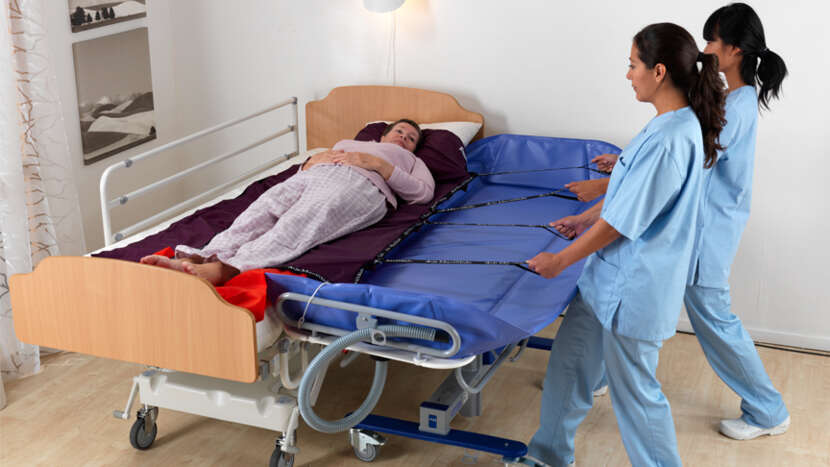Pressure ulcers, also known as bedsores or decubitus ulcers, are one of the most common and preventable complications in patients with limited mobility. These injuries occur when prolonged pressure on the skin restricts blood flow, leading to tissue damage. One of the most effective methods to reduce the risk of pressure ulcers during patient transfers is the use of transfer sheets.
What Are Pressure Ulcers?
Pressure ulcers develop when a patient remains in one position for extended periods, typically in a bed or chair, which exerts continuous pressure on specific areas of the body. The most common sites for pressure ulcers include the heels, hips, elbows, and the sacral region. Pressure ulcers can range from mild redness to deep, open wounds that expose muscle and bone.
How Pressure Ulcers Occur During Patient Transfers
Patient transfers—whether from a bed to a wheelchair, from one bed to another, or from a lying to a sitting position—can increase the risk of pressure ulcers if not performed correctly. Without proper handling, friction and shear forces can be introduced during the movement, leading to skin irritation and damage. Additionally, the improper positioning of patients during transfers can exacerbate the pressure on certain body parts, increasing the risk of ulcer formation.
The Importance of Transfer Sheets in Preventing Pressure Ulcers
Transfer sheets are designed to help healthcare professionals and caregivers safely move patients without excessive friction or pressure on their skin. They are often made from smooth, low-friction materials that help reduce the risk of skin damage during transfers. These sheets can be especially useful in preventing pressure ulcers by minimizing the shear and friction forces that can contribute to tissue injury.
Key Benefits of Transfer Sheets in Preventing Pressure Ulcers:
- Reduced Friction: Transfer sheets are typically designed with a smooth surface that allows for easy movement. This reduces the amount of friction that occurs between the patient’s skin and the surface they are being moved on, which can otherwise lead to abrasions and damage.
- Minimized Shear Forces: Shear forces occur when the skin moves in one direction while the underlying tissue moves in another. Transfer sheets help to reduce these forces by providing a stable, smooth surface for the patient to slide along, preventing skin layers from being stretched and torn.
- Even Distribution of Pressure: A well-positioned transfer sheet helps distribute the patient’s weight more evenly across their body, reducing the concentrated pressure on any one area. This can help prevent the development of pressure ulcers, especially in high-risk areas like the sacrum, heels, and elbows.
- Improved Comfort for the Patient: By reducing friction and shear, transfer sheets also improve the overall comfort of the patient during transfers. This makes it easier for both caregivers and patients to manage transfers, especially for those who are non-ambulatory or have limited mobility.
- Support for Proper Positioning: Transfer sheets not only help with movement but also assist in positioning the patient correctly after transfer. Correct positioning helps reduce pressure points and provides support to areas at risk of ulcer formation.
How to Use Transfer Sheets to Reduce Pressure Ulcers
Using transfer sheets effectively is key to preventing pressure ulcers. Here are some tips for optimal usage:
- Ensure Proper Sizing: Transfer sheets come in different sizes. Make sure the sheet is large enough to cover the patient adequately while still allowing for easy movement. A sheet that is too small may increase friction, while one that is too large could shift during the transfer, potentially causing instability.
- Proper Technique: During transfers, ensure that the caregiver uses proper lifting techniques to reduce the amount of lifting and pulling needed. Ideally, at least two caregivers should assist with the transfer to distribute the patient’s weight evenly and ensure that the transfer sheet stays in place.
- Use Transfer Sheets with Anti-Slip Features: Many transfer sheets come with anti-slip properties that prevent the sheet from sliding off during the transfer. This can further reduce the risk of friction and shear and ensure that the patient remains securely positioned.
- Regularly Monitor the Patient: Even with the use of transfer sheets, it’s essential to monitor the patient regularly for signs of pressure ulcers, especially in vulnerable areas like the heels, sacral region, and elbows. Early detection and intervention are key to preventing further damage.
Choosing the Right Transfer Sheet
When selecting a transfer sheet for preventing pressure ulcers, there are several factors to consider:
- Material: Look for transfer sheets made from smooth, durable, and breathable materials that will reduce friction while also providing comfort. Materials like nylon, polyester, and other low-friction fabrics are commonly used.
- Size and Fit: The sheet should be large enough to fit comfortably under the patient and provide adequate coverage. A good fit will make transfers easier and reduce the risk of the sheet shifting during movement.
- Weight Capacity: Ensure that the transfer sheet is strong enough to support the weight of the patient without tearing or becoming damaged during use.
- Ease of Cleaning: Since transfer sheets are often exposed to bodily fluids, it’s important to select sheets that are easy to clean and maintain hygiene. Many transfer sheets are machine washable and quick-drying.
Conclusion
Transfer sheets are an invaluable tool in healthcare settings for preventing pressure ulcers and ensuring safe, comfortable patient transfers. By reducing friction and shear forces, promoting proper positioning, and enhancing comfort, transfer sheets help caregivers move patients without causing harm to their skin. For patients with limited mobility or those at high risk of pressure ulcers, using transfer sheets is a simple yet effective way to significantly reduce the likelihood of developing these painful and potentially dangerous injuries.

